The Huawei P8 Lite Review
by Brandon Chester on July 27, 2015 8:00 AM EST- Posted in
- Smartphones
- Huawei
- Mobile
Display
The Huawei P8 Lite has a 5.0" 1280x720 IPS display. We've seen great improvements to both display resolution and color accuracy in recent years, and you can now get highly accurate 720p panels in devices that cost only $150-$200. Some devices even manage to squeeze a 1080p panel onto a $200 device. Since competing on resolution has become difficult, targeting greater color accuracy has become the next step of display improvements. To evaluate the accuracy of the P8 Lite's display we turn to our standard smartphone display workflow. As always, measurements are performed with X-Rite's i1Pro 2 spectrophotometer and SpectraCal's CalMAN 5 software, with the exception of contrast measurements which are done with an i1Display Pro colorimeter.
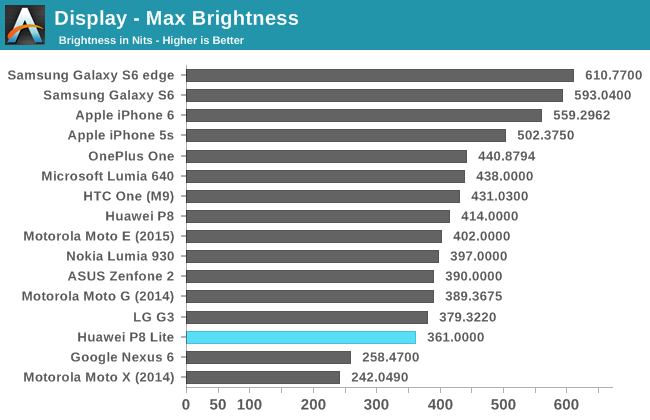
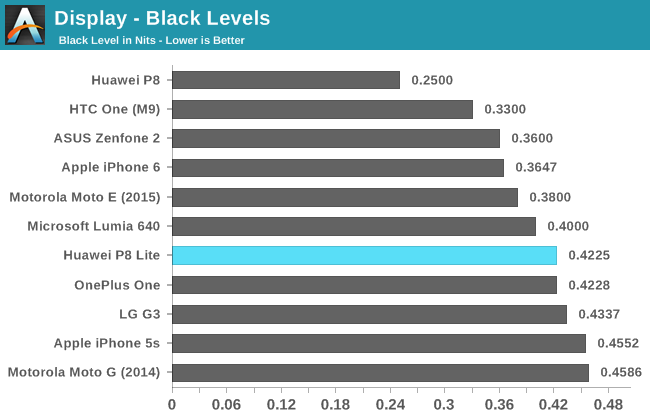
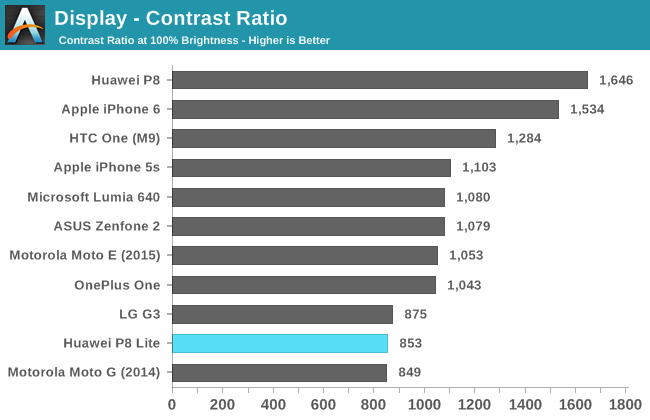
At 361 nits, the P8 Lite's display isn't quite as bright as I would expect. Despite this, the black level is fairly high, which leads to one of the lower contrast ratios on record. At this point having your brightness far below 400 nits is really not acceptable, as it makes the device very difficult to use in the sun or with other unforgiving lighting. The high black level also means that the wash out from external lighting is even more noticable.
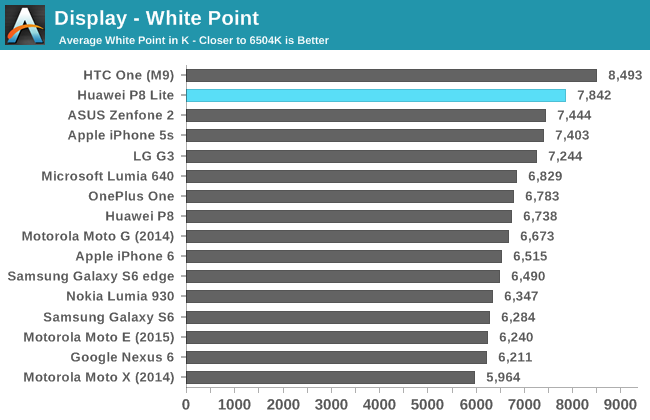

Greyscale results from the P8 Lite also end up being less than optimal. With a price point of $249, Huawei is within the mid-range segment of the market. Devices like the Lumia 640 have shown that it's completely possible to ship an accurate display even with price constraints. The P8 Lite's display is far too blue, and there's a high degree of error in shades of grey which increases as they move toward complete white.
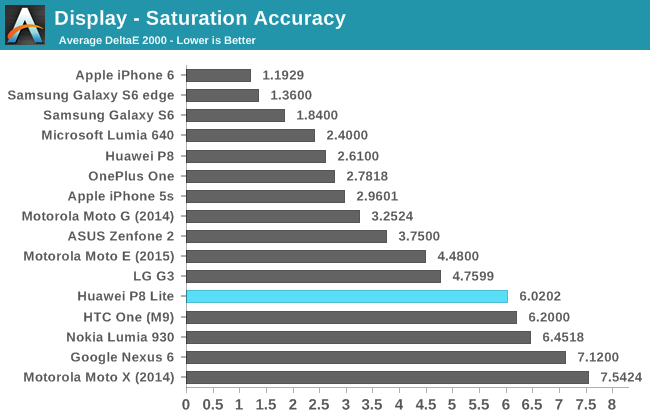
The P8 Lite again performs poorly in the saturation sweep test. Blue shows some saturation compression, with slight oversaturation until it hits 80% and then undersaturation for the deepest shades of blue. Magenta misses the mark severely, with 20% magenta actually being what would be a very accurate 20% blue. The level of inaccuracy is high enough to be fairly evident throughout the UI, which is very disappointing.
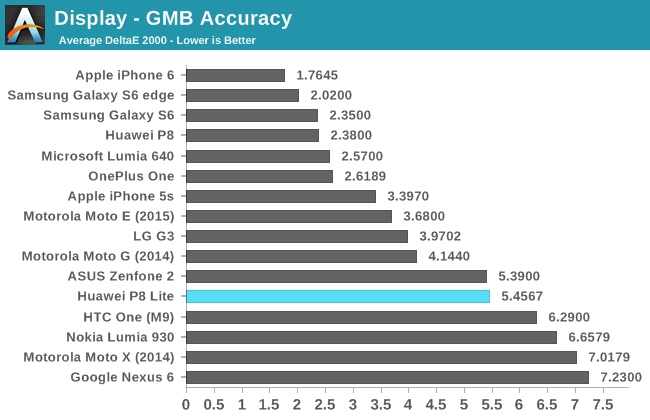
In the ColorChecker test the P8 Lite again doesn't do very well. The inaccuracy with both the greyscale and the primary and secondary colors means there's not much hope of rendering color mixtures accurately. As you can see in the color comparator image, there's a high level of error in everything except the greens and cyan. It's fairly clear when looking at images or videos that they don't look quite right.
Overall, the P8 Lites display is fairly disappointing. We've seen great improvement in display quality in the low end and mid range parts of the market, with $149 devices like the Lumia 640 providing very high accuracy and good sharpness, and the ASUS Zenfone 2 providing decent accuracy and a very high resolution. The 5.0" 720p display on the P8 Lite is decently sharp, but the inaccuracy is significant.


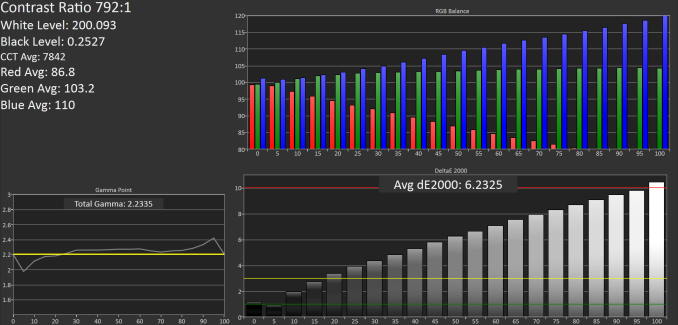

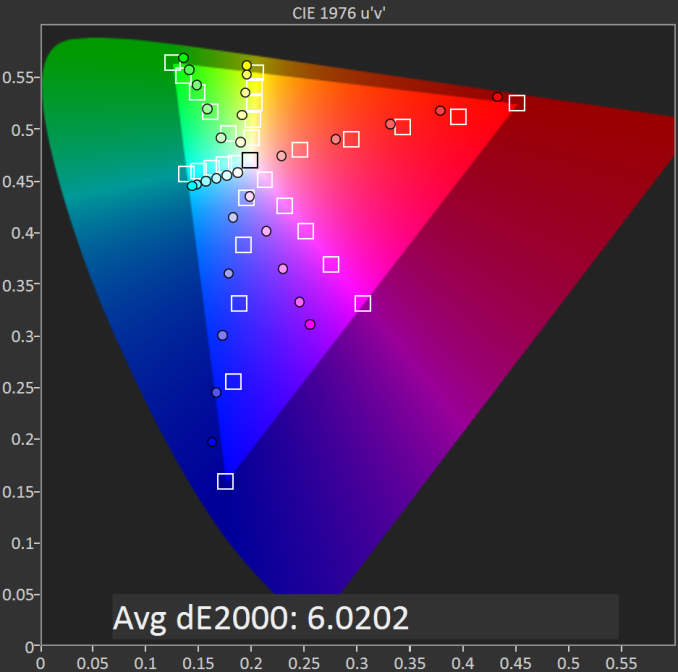










45 Comments
View All Comments
joeroyhud - Monday, July 27, 2015 - link
The P8 Lite supports LTE band 12, which makes it attractive if you're a T-Mobile customer like I am. I got the phone on sale a couple months ago for $200. I like the size and the performance and the battery life, but it's overpriced at $250.Glock24 - Monday, July 27, 2015 - link
This phone seems like a bad choice. Glad I got a ZenFone 2, but sure since I got the 4GB RAM/64GB flash version it cost me $300. Battery life on ZF2 is not great, but has improved a bit with system updates. I guess if the P8 Lite had Android 5.0 it would have even worse battery life.austinsguitar - Monday, July 27, 2015 - link
g4 pleaseedwd2 - Monday, July 27, 2015 - link
SD615 is a plain no for me. It's arguably worse than the SD600 and the MT6752 smokes it in every aspect at a lower price point.Speedfriend - Tuesday, July 28, 2015 - link
"As for performance, Snapdragon 615 is really the best you're going to get at this price point unless you go with the Zenfone 2 which is something of an anomaly in many ways. "Which begs the question why more manufacturers aren't using Intel chips which clearly smash the performance of any other mid range priced offerings?
Stick an Intel chip in a Moto G and I'll buy that!
LiverpoolFC5903 - Tuesday, July 28, 2015 - link
Agree, I dont understand why more manufacturers do not use the newer Silvermont based Intel chips, considering the performance levels and the low price. Much better than using mediocre socs like Snapdragon 410/615 at similar price points. Having used the ZF2, I can personally attest to its performance in handling anything Android has to offer.Buk Lau - Wednesday, July 29, 2015 - link
The answer is simple, Intel chips don't come with integrated modems. just look at zenfone 2, that thing comes with XMM 7262 with CAT 6 LTE disabled, and if this doesn't show you the problem already, Qualcomm's Gobi modem even comes with integrated GPS solution whereas Asus has to include a Broadcom solution. so just by using these atoms you already have to include 2 other chips whereas Qualcomm just gives you an all-in-one solution. then the choice is obvious, unless intel is literally paying money to you, which they did, what incentive is there for you to use their more complicated solution instead of qualcomm's? and this is how qualcomm got to become what it is today. back in the old days qualcomm's SoCs suffered even worse overheating and performance and yet OEMs still persist to use their stuff, simply because they offered an integrated modem. in a sense, OEMs only have themselves to blame rather than qualcomm for having to release junk phones all over this year, if they didn't spoil qualcomm so much back then, there wouldn't be so little choices in the SoC marketBadelhas - Tuesday, July 28, 2015 - link
The European / Asian version has Lollipop UI Emotion 3.1 and the their own HiSilicon's Kirin 620 SoC. Is it possible to review that one? Seems much better than the American version...A friend of mine bought one and it´s pretty slick, even if I continue to prefer the Moto E, considering the price.
PrinceGaz - Tuesday, July 28, 2015 - link
eww, you've got really hairy arms! (just joking, there were complaints in the comments about the iWatch that the guy wearing it had hairless arms :)So why would I want a phone with eight A53 CPUs? In my experience with a quad-core tablet, it rarely uses more than two of them fully when it is running at full speed, with the third and fourth cores doing a bit of work but hardly ever even approaching fully utilised (probably just running the tasks that need to be run anyway, so their main purpose is taking a tiny bit of work off the other cores).
Given that a 64-bit CPU is a bit unnecessary when phones have yet to reach 4GB RAM, and probably counter-productive power-wise as a result (just look at A15/A7 vs A57/A53), whilst benchmarks may run faster on a quad-core 1.5GHz A53, I suspect I'm better off with my old dual-core 1.7GHz Krait for most daily usage. It lasts me all day and never feels slow, and most of the time (according to a CPU usage monitor) one of the cores isn't being used much. I don't play 3D games much on my phone; so I never tax the GPU, therefore the Adreno 305 is perfectly fine for me,
What workload other than benchmarks requires more than two CPU cores? The main one that occurs to me is a browser, in which case you would be much better off culling battery draining processes rather than running them.
Ethos Evoss - Saturday, August 1, 2015 - link
pls honor 7 reviewthnx